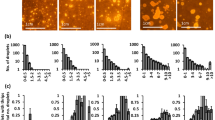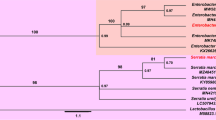Abstract
Insecticidal and repellent activities were evaluated on extracts from three macroalgae (Caulerpa sertularioides, Laurencia johnstonii and Sargassum horridum) against Diaphorina citri adults. The ethanolic extracts were obtained by maceration, filtration, and concentration under reduced pressure at 40 °C. Each extract was fractionated by solid-liquid methods, followed by column fractionation. The fractions obtained were analyzed by phytochemical tests to determinate their chemical composition. The three extracts showed alkaloids, terpenes, phenols, tannins, flavonoids, anthraquinones and saponins, which are associated with insecticidal and repellent activity. The repellency assay with S. horridum extract showed repellent activity over 24 h (Index of Behavioral Tendency, IBT = 0.376 ± 0.047), L. johnstonii extract showed repellency during 18 h (IBT = 0.240 ± 0.034). Although C. sertularioides extract at the beginning produced an attractant effect (during the first 4 h), it was followed by a repellent effect after 12 h (IBT = 0.297 ± 0.041). The repellent control used was Neemix 4.5 (azadirachtin) and it has a longer repellency of over the 24 h, however S. horridum had a higher repellent activity over the control during all the assay. In the insecticidal activity assay, lethal doses were calculated for each species: L. johnstonii (LD50 = 284 μg mL−1), S. horridum (LD50 = 364 μg mL−1), and C. sertularioides (LD50 = 3703 μg mL−1). Additionally, three terpenic compounds isolated from L. johnstonii were identified by GC/MS; debromolaurinterol, isolaurinterol, and laurinterol as potential insecticidal and repellent compounds. The results suggest that seaweed extracts represent an alternative in the development of agrochemicals for pest control.





Similar content being viewed by others
References
Abbasy MA, Marzouk MA, Rabea EL, Abd-Elnabi AD (2014) Insecticidal and fungicidal activity of Ulva lactuca Linnaeus (Chlorophyta) extracts and their fractions. ARRB 4:2252–2262
Abbott WS (1925) A method of computing the effectiveness of an insecticide. J Econ Entomol 18:265–267
Argadoña V, Del Pozo T, San-Martín A, Rovirosa J (2000) Insecticidal activity of Plocamium cartilagineum monoterpenes. Bol Soc Chil Quim 45:371–376
Asha A, Rathi JM, Raja D, Sahayaraj K (2012) Biocidal activity of two marine green algal extracts against third instar nymph of Dysdercus cingulatus (Fab.) (Hemiptera:Pyrrhocoridae). J Biopest 5:129–134
Asharaja A, Sahayaraj H (2013) Screening of insecticidal activity of brown macroalgal extracts against Dysdercus cingulatus (Fab.) (Hemiptera:Pyrrhocoridae). J Biopest 6:193–203
Bianco EM, Pires L, Santos GKN, Dutra KA, Reis TNV, Vasconcelos E, Cocentino A, Navarro D (2013) Larvicidal activity of seaweeds from northeastern Brazil and of a halogenated sesquiterpene against the dengue mosquito (Aedes aegypti). Ind Crop Prod 43:270–275
Boina DR, Onagbola EO, Salyani M, Stelinski LL (2009) Antifeedant and sublethal effects of imidacloprid on Asian citrus psyllid, Diaphorina citri. Pest Manag Sci 65:870–877
Bové JM (2006) Huanglongbing: a destructive, newly emerging, century-old disease of citrus. JPP 1:7–37
Cetin H, Gokoglu M, Oz E (2010) Larvicidal activity of the extract of seaweed, Caulerpa scalpelliformis, against Culex pipiens. J Am Mosq Control Assoc 26:433–436
Choudhary A, Naughton LM, Montánchez I, Dobson AD, Rai DK (2017) Current status and future prospects of marine natural products (MNP’s) as antimicrobials. Mar Drugs 15:1–42
Da Graca JV (1991) Citrus greening disease. Rev Phytopathol 29:109–136
De Geyter E, Lambert E, Geelen D, Smagghe G (2007) Novel advances with plant saponins as natural insecticides to control pest insects. Pest Technol 1:96–105
El Sayed KA, Dunbar DC, Perry TL, Wilkins SP, Hamann MT (1997) Marine natural products as prototype insecticidal agents. J Agric Food Chem 45:2735–2739
Finney DJ (1971) Probit analysis. Cambridge University Press, New York, p 333
Fukuzawa A, Masamune T (1981) Laurenpinnacin ans isolaurenpinnacin: new acetylenic cyclic ethers from the marine alga Laurencia pinnata Yamada. Tetrahedron Lett 22:4081–4084
García-Davis S, Sifaoui I, Reyes-Batlle M, Vivero-Valdez E, Piñero JE, Lorenzo-Morales J, Fernández JJ, Díaz-Marrero AR (2018) Anti-Acanthamoeba activity of brominated sesquiterpenes from Laurencia johnstonii. Mar Drugs 16:443
Gupta S, Abu-Ghannam (2011) Recent developments in the application of seaweeds or seaweeds extracts as a means for enhancing the safety and quality attributes of foods. Innov Food Sci Emerg 12:600–609
Harborne JD (1998) Phytochemical methods: guide to modern techniques of plant analysis. Chapman & Hall, London, p 302
Hemingway J, Field L, Vvontas J (2002) An overview if insecticide resistance. Science 298:96–97
Hernández-Herrera R, Santacruz-Ruvalcaba F, Ruiz-López MA, Norrie J, Hernández-Carmona G (2013) Effect of liquid seaweed extracts on growth of tomato seedlings (Solanum lycopersicum L.). J Appl Phycol 26:619–628
Ishaaya I, Horowitz R (2007) In focus: IPM using novel insecticides and other approaches. Pest Manag Sci 63:729
Ishii T, Nagamine T, Ngunyen BCQ, Tawata S (2017) Insecticidal and repellent activities of laurinterol from the Okinawan red alga Laurencia nidifica. Rec Nat Prod 11:63–68
Isman M (2008) Botanical insecticides: for richer, for poorer. Pest Manag Sci 64:8–11
Jagoueix S, Bové JM, Garnier M (1994) The phloem-limited bacterium of greening disease of citrus is a member of the α subdivision of the proteobacteria. Int J Syst Evol Microbiol 44:379–386
Khan W, Rayirath UP, Subramanian S, Jithesh MN, Rayorath P, Hodges DM, Prithiviraj B (2009) Seaweeds extracts as biostimulants of plant growth and development. J Plant Growth Regul 28:386–399
Manilal A, Sujith S, Sabarathnam B, Kiran G, Selvin J, Shakir C, Lipton AP (2011) Biological activity of the red alga Laurencia brandenii. Acta Bot Croat 70:81–90
Ouyang G, Fang X, Lu H, Zhou X, Meng X, Yu S, Guo M, Xia Y (2013) Repellency of five mineral oils against Diaphorina citri (Hemiptera: Liviidae). Fla Entomol 96:974–983
Peng J, Shen X, El Sayed KA, Dunbar DC, Perry TL, Wilkins SP, Hamann T (2003) Marine natural products s prototype agrochemical agents. J Agric Food Chem 51:2246–2252
Presidencia de la república (2018a) Available online: http://calderon.presidencia.gob.mx/2009/06/mexico-quinto-productor-mundial-de-citricos-sagarpa/ (accessed on 4 November 2018)
Presidencia de la república (2018b) Available online: https://www.gob.mx/senasica/documentos/huanglongbing-de-los-citricos-110925 (accessed on 4 November 2018)
Rattan RS (2010) Mechanism of action of insecticidal secondary metabolites of plant origin. Crop Prot 29:913–920
Sahayaraj K, Jeeva YM (2012) Nymphicidal and ovipositional efficacy of seaweed Sargassum tenerrimum (J. Agardh) against Dysdercus cingulatus (Fab.) (Pyrrhocoridae). Chilean J Agric Res 72:152–156
Sahayaraj K, Kalidas S (2011) Evaluation of nymphicidal and ovicidal effect of a seaweed, Padina pavonica (Linn.) (Phaeophyceae) on cotton pest, Dysdercus cingulatus (Fab). Indian J Pharm Sci 40:125–129
Sahayaraj K, Rajesh S, Asha A, Rathi JM (2012) Marine algae for the cotton pest and disease management. In: Conference Proceedings of the International Conference on and Engineering (ICASE 2012). 1:49-62
Salvador-Neto O, Gomez SA, Machado AR, Samuels FL, Nunes da Fonseca RI, Souza-Menezes J, Morales JL, Campos E, Mury FB, Silva JR (2016) Larvicidal potential of halogenated sesquiterpene (+)-Obtusol, isolated from the alga Laurencia dendroidea J. Agardh (Ceramiales:Rhodomelaceae), against the dengue vector mosquito Aedes aegypti (Linnaeus) (Diptera:Culicidae). Mar Drugs 14:1–14
Sharma OP (2011) Algae, series on diversity of microbes and cryptograms. McGraw Hill, New Delhi, p 389
Smit AJ (2004) Medicinal and pharmaceutical uses of seaweed natural products: a review. J Appl Phycol 16:245–262
Stephenson WM (1966) The effect of hydrolysed seaweed on certain plant pests and diseases. In: Gordon Young E, McLachlan JL (eds) Proceedings of the Fifth International Seaweed Symposium, Halifax. Pergamon, New York, pp 405–415
Watanabe K, Umeda K, Miyakado M (1989) Isolation and identification of three insecticidal principles from the red alga Laurencia nipponica Yamada. Agric Biol Chem 53:2513–2515
Yu KX, Jantan I, Ahmad R, Wong CL (2014) The major bioactive components of seaweeds and their mosquitocidal potential. Parasitol Res 113:3121–3141
Yu KX, Wong CL, Ahmad R, Jantan I (2015) Larvicidal activity, inhibition effect on development, histopathological alteration and morphological aberration induce by seaweed extracts in Aedes aegypti (Diptera: Culicidae). Asian Pac J Trop Med 8:1006–1012
Zhao H, Sun R, Albrecht U, Padmanabhan C, Wang A, Coffey MD, Girke T, Wang Z, Close TJ, Roose M, Yokomi RK, Folimonova S, Vidalakis G, Rouse R, Bowman KD, Jin H (2013) Small RNA profiling reveals phosphorus deficiency as contributing factor in symptom expression for citrus Huanglongbing disease. Mol Plant 6:301–310
Acknowledgments
Gustavo Hernández and Mauricio Muñoz thanks to the Instituto Politécnico Nacional for the support from the “Beca de Exclusividad (COFAA) and “Estimulo al Desempeño de los Investigadores (EDI).
Funding
This study received financial support from the Consejo Nacional de Ciencia y Tecnologia (CONACyT).
Author information
Authors and Affiliations
Corresponding author
Additional information
Publisher’s note
Springer Nature remains neutral with regard to jurisdictional claims in published maps and institutional affiliations.
Rights and permissions
About this article
Cite this article
González-Castro, A.L., Muñoz-Ochoa, M., Hernández-Carmona, G. et al. Evaluation of seaweed extracts for the control of the Asian citrus psyllid Diaphorina citri. J Appl Phycol 31, 3815–3821 (2019). https://doi.org/10.1007/s10811-019-01896-5
Received:
Revised:
Accepted:
Published:
Issue Date:
DOI: https://doi.org/10.1007/s10811-019-01896-5




